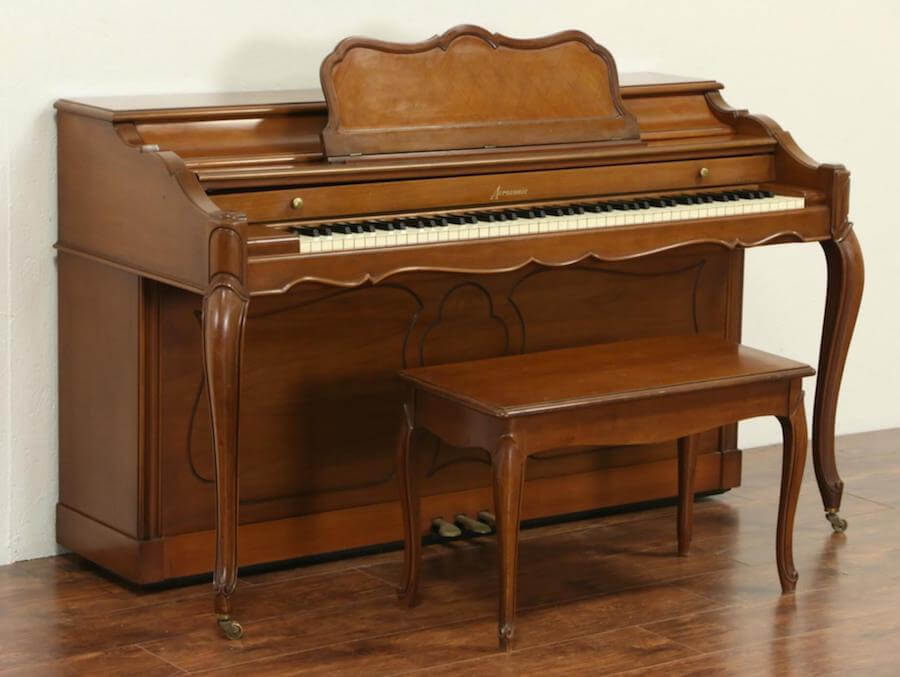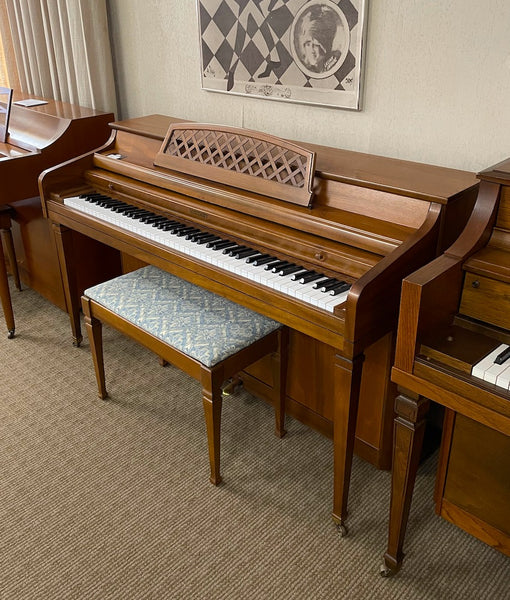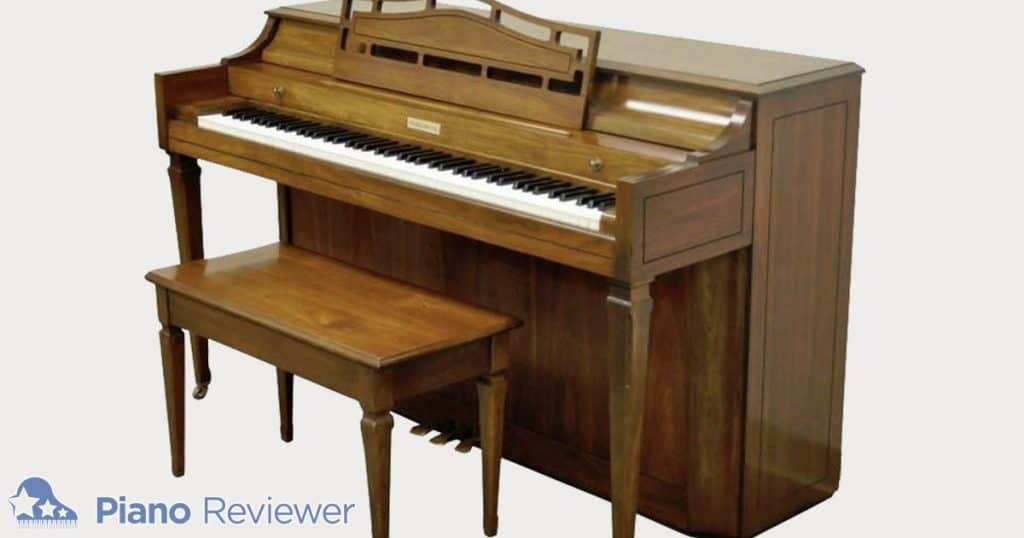Have you ever wondered what makes a spinet piano unique? Perhaps you’re considering buying one or are simply curious about this compact musical instrument.
You’re not alone. Many people find themselves intrigued by its distinct design and sound. Understanding what a spinet piano is can open up a new perspective on music and might even inspire you to play a few notes yourself. You’ll discover the characteristics of spinet pianos, what sets them apart from other types, and why they could be the perfect addition to your home.
Keep reading to uncover the fascinating world of spinet pianos, and see why they might be just the musical treasure you’ve been searching for.

Credit: europianosnaples.com
Table of Contents
ToggleThe History Of Spinet Pianos
Welcome to the fascinating journey of spinet pianos—a unique corner of the musical world that has captured the hearts of many. Whether you’re a seasoned musician or a curious beginner, understanding the history of spinet pianos offers insights into their charm and enduring appeal. Let’s dive into their origins and popularity throughout the 20th century.
Origins And Evolution
Spinet pianos emerged during the late 1930s as a space-saving solution. Their compact design made them ideal for homes with limited space. Unlike traditional upright pianos, spinets feature shorter strings and a smaller soundboard.
Their design was revolutionary for its time. Manufacturers aimed to provide the rich tones of a full-sized piano without the bulk. This innovation allowed more people to experience the joy of playing piano.
Imagine inviting a spinet piano into your living room, transforming the space into a music sanctuary. It was a chance to own an instrument that blended functionality with elegance.
Popularity In The 20th Century
Spinet pianos hit their stride in the mid-20th century. They became a staple in homes across America, cherished for their affordability and compact size. Families found them perfect for sing-alongs and family gatherings.
During the 1950s and 60s, spinet pianos were in high demand. Advertisements often highlighted their stylish design and ease of use. People sought them for their ability to bring music into everyday life.
Perhaps you remember visiting your grandparents’ house, where a spinet piano stood proudly in the corner. It offered a gateway to musical exploration, sparking creativity and joy in the hearts of many.
What does this tell us about the role of music in our lives? Spinet pianos remind us that music is accessible, adaptable, and essential for enriching our world.

Credit: www.alamomusic.com
Design Characteristics
A spinet piano is compact, making it ideal for small spaces. Its strings run vertically, giving it a unique sound. This design is perfect for beginners or casual players seeking an affordable option.
The spinet piano, a charming addition to many homes, is known for its unique design characteristics. Its compact size and intriguing mechanical structure distinguish it from other types of pianos. Whether you’re a seasoned pianist or a curious beginner, understanding these design elements can offer valuable insights into why the spinet piano has remained a popular choice for many.
Compact Size And Structure
One of the most appealing features of the spinet piano is its compact size. Perfect for small living spaces, it fits snugly in a cozy corner or against a wall without overwhelming the room. This makes it an ideal choice for those who love music but need to maximize their space. The spinet’s design is distinct, with a shorter back and a drop-action mechanism. These features contribute to its petite stature, allowing it to stand at a modest height compared to other pianos. If you’ve ever struggled to find space for a larger instrument, the spinet piano offers a practical solution.
Mechanics And Action
The mechanics of a spinet piano are a fascinating aspect of its design. Unlike traditional pianos, spinets use an indirect blow action, known as a “drop action.” This means the hammers are positioned lower, with rods connecting them to the keys, making the piano more compact. However, this design can make it a bit more challenging to maintain and tune. The indirect action can sometimes affect the touch and responsiveness, which might require some adjustment for pianists used to larger pianos. Have you ever considered how the mechanics of a piano could influence your playing style? Despite these challenges, many players appreciate the spinet for its unique sound and ease of placement in the home. It offers a different playing experience that some find charming and nostalgic. If you’re looking to add a piano to your life, the spinet’s design characteristics might just be the perfect fit.
Unique Sound Qualities
A spinet piano offers distinct sound qualities due to its compact design and shorter strings. Its unique tone combines warmth with a softer resonance, making it ideal for small spaces. Despite its size, the spinet provides a rich, full sound that appeals to many music lovers.
The spinet piano is a fascinating instrument with unique sound qualities that captivate musicians and listeners alike. Despite its smaller size, it offers a distinct sound that sets it apart from other pianos. If you’ve ever played a spinet piano, you might have noticed the unique texture and character in its sound. Let’s explore what makes the spinet piano’s sound so unique and how it compares to other types of pianos.
Tone And Timbre
The spinet piano has a warm, intimate tone that invites you in. Its strings are shorter, which gives it a more mellow sound compared to larger pianos. This makes it perfect for cozy spaces and small gatherings. When you play a spinet, you might feel a personal connection with the music. The timbre is soft and rounded, offering a gentle touch to your compositions. Have you ever wondered how different pianos can evoke various emotions? The spinet’s tone is ideal for creating calm and soothing atmospheres.
Comparisons With Other Pianos
How does the spinet piano stack up against other pianos? Unlike grand pianos, which offer powerful and resonant sounds, the spinet is more subtle. Its compact design limits the volume, making it less ideal for large concert halls. Upright pianos, on the other hand, provide a fuller sound due to their longer strings. However, the spinet’s charm lies in its ability to fit in tight spaces while still delivering a delightful musical experience. If you’re considering adding a piano to your home, think about the atmosphere you want to create. Do you prefer the intimate feel of a spinet, or the grand presence of a larger piano? Your choice can significantly impact your music journey. The spinet piano might not be the first choice for professional performances, but its unique sound qualities offer a special touch to personal practice and home concerts. What kind of musical environment are you looking to create?
Advantages And Limitations
Spinet pianos offer a compact design, perfect for small spaces. Their lighter weight makes them easier to move. Despite these benefits, they have a smaller soundboard, resulting in limited sound quality. Maintenance can also be challenging due to their intricate internal structure.
The spinet piano is a charming addition to any home, offering a compact design and unique sound. While this type of piano can be a great choice for many, it’s important to weigh its advantages and limitations to decide if it fits your lifestyle and needs. This exploration into the benefits and potential drawbacks of owning a spinet will help you make an informed decision.
Benefits Of Owning A Spinet
Spinet pianos are known for their compact size, making them ideal for small spaces. If you live in an apartment or have limited room, a spinet might fit perfectly without overwhelming your space. They’re typically more affordable than larger pianos. This means you can enjoy the pleasure of owning a piano without breaking the bank. The sound of a spinet, while different from larger pianos, has a distinctive charm. It offers a unique tone that some people might find refreshing or nostalgic.
Potential Drawbacks
Spinet pianos have a smaller soundboard and shorter strings. This results in a less powerful sound compared to grand or upright pianos. If you’re looking for rich and resonant tones, this might not be the best option. Their action mechanism can be less responsive. This might affect your playing experience, especially if you prefer a more dynamic touch. Maintenance can be tricky. Due to their compact design, repairs or adjustments might require more specialized attention, which could be a hassle. Have you ever considered how the size of a piano affects the music you play? As you weigh the pros and cons, think about how a spinet piano might fit into your musical journey.
Spinet Pianos In Modern Times
Spinet pianos, once a staple in many homes, remain significant today. Their compact design and unique sound continue to attract enthusiasts. Despite newer options, spinet pianos maintain a special charm. They offer a touch of nostalgia combined with a distinctive musical experience.
Current Trends And Usage
Today, spinet pianos find a place in both homes and studios. Their small size makes them ideal for limited spaces. Many musicians appreciate their warm, intimate sound. The spinet’s unique design also appeals to vintage decor enthusiasts. Although less common than larger pianos, they still hold a niche market. Music schools sometimes use them for beginner lessons. Their affordable price compared to larger models adds to their appeal.
Collecting And Restoring
Collecting spinet pianos has become a popular hobby. Many enjoy seeking out rare or antique models. Restoring these pianos breathes new life into their aged frames. Restoration often involves repairing keys and tuning the strings. Skilled craftsmen can revitalize a spinet’s appearance and sound. Collectors value these restored instruments for their historical significance. Each spinet piano tells a story from its time. The restoration process can be rewarding for those passionate about music history.

Credit: pianoreviewer.com
Frequently Asked Questions
What Is The Difference Between A Spinet And A Piano?
A spinet is a smaller, compact type of harpsichord or upright piano. Pianos are larger with a full range of dynamics. Spinets are limited in size and sound, often used in tight spaces. Pianos offer richer tones and greater expressive capabilities, suitable for concert performances.
How Can I Tell If A Piano Is A Spinet?
Identify a spinet piano by its compact size and short height, usually under 40 inches. Spinet pianos have a drop action, meaning the strings and hammers are positioned lower. The keyboard sits directly above the action, making it look smaller compared to larger upright pianos.
What Are The Advantages Of A Spinet Piano?
Spinet pianos are compact and space-efficient, perfect for small rooms. They offer affordability and are easier to move. Their charming, vintage design appeals to many homeowners. Despite their smaller size, they still provide a satisfying playing experience for beginners and casual musicians.
Can Spinet Pianos Be Tuned?
Yes, spinet pianos can be tuned. Regular tuning helps maintain sound quality and extends the piano’s lifespan. Professional tuners use specialized tools to adjust the tension of the strings. It’s recommended to tune spinet pianos at least once a year.
Proper maintenance ensures optimal performance and enhances musical experience.
Conclusion
Spinet pianos offer a compact choice for music lovers. Their small size suits tight spaces perfectly. This makes them ideal for apartments and cozy homes. Sound quality may differ from larger pianos, but they still provide pleasure. Perfect for beginners or those with limited room.
Owning a spinet can bring music into everyday life. Consider your needs and space before choosing one. A spinet piano might just be what you need. Experience the joy of playing without the bulk. Find the right fit and enjoy creating beautiful music at home.
